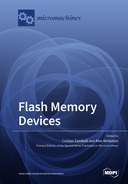Explore

Flash Memory Devices
0 Ungluers have
Faved this Work
Login to Fave
Flash memory devices have represented a breakthrough in storage since their inception in the mid-1980s, and innovation is still ongoing. The peculiarity of such technology is an inherent flexibility in terms of performance and integration density according to the architecture devised for integration. The NOR Flash technology is still the workhorse of many code storage applications in the embedded world, ranging from microcontrollers for automotive environment to IoT smart devices. Their usage is also forecasted to be fundamental in emerging AI edge scenario. On the contrary, when massive data storage is required, NAND Flash memories are necessary to have in a system. You can find NAND Flash in USB sticks, cards, but most of all in Solid-State Drives (SSDs). Since SSDs are extremely demanding in terms of storage capacity, they fueled a new wave of innovation, namely the 3D architecture. Today “3D” means that multiple layers of memory cells are manufactured within the same piece of silicon, easily reaching a terabit capacity. So far, Flash architectures have always been based on "floating gate," where the information is stored by injecting electrons in a piece of polysilicon surrounded by oxide. On the contrary, emerging concepts are based on "charge trap" cells. In summary, flash memory devices represent the largest landscape of storage devices, and we expect more advancements in the coming years. This will require a lot of innovation in process technology, materials, circuit design, flash management algorithms, Error Correction Code and, finally, system co-design for new applications such as AI and security enforcement.
This book is included in DOAB.
Why read this book? Have your say.
You must be logged in to comment.
Rights Information
Are you the author or publisher of this work? If so, you can claim it as yours by registering as an Unglue.it rights holder.Downloads
This work has been downloaded 74 times via unglue.it ebook links.
- 74 - pdf (CC BY) at Unglue.it.
Keywords
- 3D flash memory
- 3D NAND Flash
- 3D NAND Flash memories
- 3D NAND flash memory
- aluminum oxide
- artificial neural network
- dipole
- Disturbance
- effective work function
- endurance
- erase performance
- error correction code
- Flash memory reliability
- flash signal processing
- garbage collection
- high-k
- high-κ
- interfacial reaction
- Interference
- metal gate
- MHONOS
- n/a
- NAND flash memory
- non-volatile memory (NVM)
- nonvolatile charge-trapping memory
- NOR flash memory
- performance cliff
- program
- random telegraph noise
- randomization scheme
- raw bit error
- RBER
- read disturb
- Reliability
- retention characteristic
- SiO2
- solid-state drives
- stack engineering
- support vector machine
- tail latency
- Technology Computer Aided Design (TCAD) simulation
- Technology, engineering, agriculture
- Technology: general issues
- temperature
- test platform
- work function
Links
DOI: 10.3390/books978-3-0365-3013-0Editions

